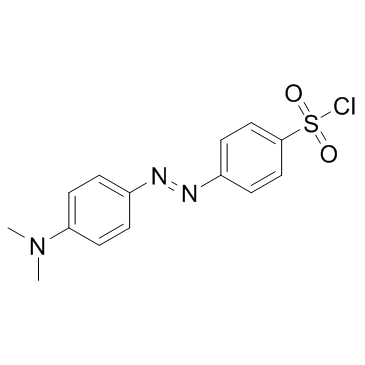Dabsyl chloride

Dabsyl chloride structure
|
Common Name | Dabsyl chloride | ||
|---|---|---|---|---|
| CAS Number | 56512-49-3 | Molecular Weight | 323.79800 | |
| Density | 1.29 g/cm3 | Boiling Point | 483.6ºC at 760 mmHg | |
| Molecular Formula | C14H14ClN3O2S | Melting Point | 185 °C (dec.)(lit.) | |
| MSDS | Chinese USA | Flash Point | 246.3ºC | |
| Symbol |

GHS05 |
Signal Word | Danger | |
Use of Dabsyl chlorideDabsyl chloride is an amine derivatizing agent, able to give rise to stable products that can be easily monitored spectrophotometrically at 460 nm; Dabsyl chloride also used for labeling amino acids. |
| Name | dabsyl chloride |
|---|---|
| Synonym | More Synonyms |
| Description | Dabsyl chloride is an amine derivatizing agent, able to give rise to stable products that can be easily monitored spectrophotometrically at 460 nm; Dabsyl chloride also used for labeling amino acids. |
|---|---|
| Related Catalog | |
| In Vitro | Dabsyl chloride can give rise to mono-Dabsyl and bis-Dabsyl derivatives in the presence of multiple amino groups. Furthermore with respect to OPA derivatization, Dabsyl chloride can react with primary and also with secondary amines[1]. |
| Cell Assay | Selected mouse brain samples from either cortical or striatal regions (100 mg wet weight) and neuroblastoma cells (SH-SY5Y) pellet derived from 25 cm2 flask are treated with 500 μL of 0.1 M HCl containing 0.2% TDGA, sonicated for 10 min (only for brain tissue), and then centrifuged at 14000 g for 30 min. The supernatant is freeze-dried. 50 μL of reaction buffer and 100 μL of 15 mM Dabsyl chloride are added to the tube and derivatized. |
| References |
| Density | 1.29 g/cm3 |
|---|---|
| Boiling Point | 483.6ºC at 760 mmHg |
| Melting Point | 185 °C (dec.)(lit.) |
| Molecular Formula | C14H14ClN3O2S |
| Molecular Weight | 323.79800 |
| Flash Point | 246.3ºC |
| Exact Mass | 323.05000 |
| PSA | 70.48000 |
| LogP | 5.17630 |
| Index of Refraction | 1.607 |
| InChIKey | VTVWTPGLLAELLI-UHFFFAOYSA-N |
| SMILES | CN(C)c1ccc(N=Nc2ccc(S(=O)(=O)Cl)cc2)cc1 |
| Storage condition | −20°C |
| Water Solubility | DMF: soluble |
CHEMICAL IDENTIFICATION
HEALTH HAZARD DATAACUTE TOXICITY DATAMUTATION DATA
|
| Symbol |

GHS05 |
|---|---|
| Signal Word | Danger |
| Hazard Statements | H314 |
| Precautionary Statements | P280-P305 + P351 + P338-P310 |
| Personal Protective Equipment | Eyeshields;Faceshields;full-face particle respirator type N100 (US);Gloves;respirator cartridge type N100 (US);type P1 (EN143) respirator filter;type P3 (EN 143) respirator cartridges |
| Hazard Codes | C |
| Risk Phrases | R22;R34 |
| Safety Phrases | S26-S36/37/39-S45-S27 |
| RIDADR | UN 3261 8/PG 2 |
| WGK Germany | 3 |
| RTECS | DB8927800 |
| Packaging Group | II |
| Hazard Class | 8 |
| HS Code | 2927000090 |
| HS Code | 2927000090 |
|---|---|
| Summary | 2927000090 other diazo-, azo- or azoxy-compounds。Supervision conditions:None。VAT:17.0%。Tax rebate rate:9.0%。MFN tariff:6.5%。General tariff:30.0% |
|
A derivatization and validation strategy for determining the spatial localization of endogenous amine metabolites in tissues using MALDI imaging mass spectrometry.
J. Mass Spectrom. 49(8) , 665-73, (2014) Imaging mass spectrometry (IMS) studies increasingly focus on endogenous small molecular weight metabolites and consequently bring special analytical challenges. Since analytical tissue blanks do not ... |
|
|
Lysine-directed staining of proteins for MS-based analyses.
Electrophoresis 34(3) , 401-4, (2013) Visualization of proteins and MS-based analyses are elemental tasks in modern biochemistry. Nevertheless, reports about covalent protein dyes and their suitability for subsequent MS experiments remain... |
|
|
Spectrophotometric determination of bacitracin in bulk drug as dabsyl derivative in a range of visible light.
Acta Pol. Pharm. 68(6) , 853-8, (2011) A fast spectrophotometric method has been developed for bacitracin identification and determination after condensation reaction with dabsyl chloride. In addition, determination of dye stability of sul... |
| EINECS 260-235-1 |
| 4-[[4-(dimethylamino)phenyl]diazenyl]benzenesulfonyl chloride |
| MFCD00007444 |

